
Legal Requirements for Foreigners to Self-drive in Rwanda
Self-driving in Rwanda can be a convenient and rewarding way to explore the country’s diverse landscapes and vibrant culture. However, as a foreigner, there are certain legal requirements and regulations that you need to be aware of before hitting the road with a Rwanda car rental. Understanding these requirements will ensure a smooth and enjoyable experience during your self-drive adventure in Rwanda.
International Driving Permit (IDP)
Foreigners planning to drive in Rwanda must possess a valid International Driving Permit (IDP) along with their original driver’s license issued by their home country. The IDP serves as a translation of your driver’s license into multiple languages and is recognized as a valid form of identification in Rwanda. It’s essential to obtain an IDP before your trip to ensure compliance with local regulations.
Minimum Age Requirement
The minimum age for driving in Rwanda is 18 years old. Foreign visitors must be at least 18 years of age to legally operate a vehicle within the country. Additionally, rental car companies may have their age restrictions and requirements for renting a vehicle, so it’s advisable to check with the rental agency beforehand.
Valid Passport and Visa
Foreign visitors must have a valid passport with a visa to enter Rwanda. Ensure that your passport is valid for at least six months beyond your intended stay in the country. Visas can typically be obtained upon arrival at Kigali International Airport or online prior to your trip, depending on your nationality. Check the latest visa requirements and application procedures through the official website of the Rwanda Directorate General of Immigration and Emigration.
Vehicle Insurance
Before operating a vehicle in Rwanda, foreign drivers must ensure they have valid vehicle insurance that provides adequate coverage. This insurance is essential in the event of accidents, damage to property, or injury to individuals. While some rental companies may include insurance in their rental packages, it’s advisable for drivers to confirm the extent of coverage and consider additional insurance if necessary.
Vehicle Registration and Documentation
Foreign drivers must ensure they have all relevant documentation for the vehicle they intend to drive in Rwanda. This includes the vehicle’s registration documents, which serve as proof of ownership and contain essential information such as the vehicle identification number (VIN), make, model, and year of manufacture. Additionally, drivers should carry the vehicle’s insurance documents and any other pertinent paperwork provided by the rental company.
Traffic Regulations and Road Safety
Familiarize yourself with Rwanda’s traffic regulations and road safety guidelines to ensure a safe driving experience. In Rwanda, vehicles drive on the right side of the road, and seat belts are mandatory for all occupants of the vehicle. Speed limits, road signs, and traffic signals should be observed at all times. Avoid using mobile phones while driving, and refrain from driving under the influence of alcohol or drugs, as strict penalties may apply for violations.
Emergency Contacts and Roadside Assistance
It’s advisable to keep a list of emergency contacts and roadside assistance services handy in case of any unforeseen incidents or emergencies while driving in Rwanda. Save the contact information for local emergency services, including the police, ambulance, and fire department, as well as the contact details for your rental car agency or insurance provider.
Navigation and Maps
While Rwanda’s road network is relatively well-maintained, some rural areas may lack adequate signage or road markings. Therefore, it’s recommended to use a GPS navigation system or mobile mapping applications to navigate unfamiliar routes. Additionally, carrying a physical map of Rwanda as a backup can be helpful, especially in areas with limited internet connectivity.
Border Crossing and Permit Requirements
If you plan to drive across international borders during your stay in Rwanda, you’ll need to obtain the necessary permits and documentation for your vehicle. Cross-border travel may require additional permits, such as a temporary importation permit for your vehicle and a valid visa for entry into neighboring countries. Check the specific requirements and regulations for each border crossing well in advance to avoid any delays or complications.
In summary, self-driving in Rwanda as a foreigner requires adherence to certain legal requirements and regulations to ensure compliance with local laws and ensure a safe and enjoyable travel experience. By obtaining the necessary permits, licenses, and insurance coverage, familiarizing yourself with traffic regulations and road safety guidelines, and planning your route in advance, you can embark on a memorable self-drive adventure in Rwanda with confidence and peace of mind.
Read More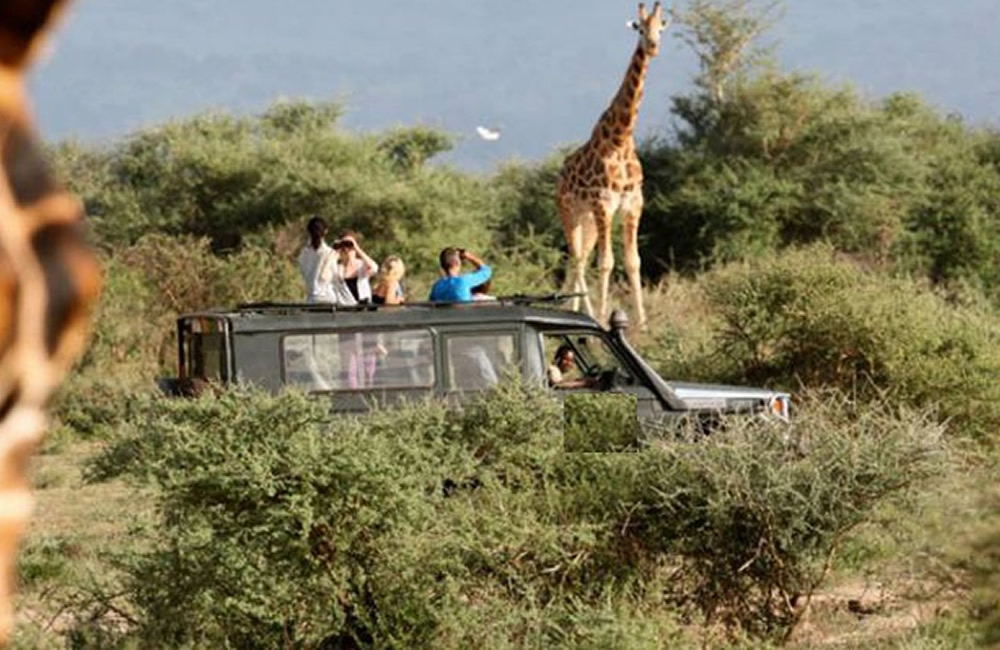
Rent a Car With a Pop-Up Roof in Rwanda
Rwanda, known as the “Land of a Thousand Hills,” is a country brimming with natural beauty, from lush rain forests to serene lake shores. Exploring this stunning landscape in a pop-up roof car is an adventure like no other, offering panoramic views and a unique experience that connects you intimately with nature.
Whether you’re embarking on a safari adventure, exploring Rwanda’s national parks, or simply enjoying a scenic drive through the countryside, adhering to the below information will help you navigate the roads of Rwanda safely and responsibly while maximizing your enjoyment of the journey.
Features Of a Pop-Up Roof Car
Pop-up roof cars come equipped with various features to enhance your driving experience and ensure your comfort during your journey through Rwanda’s diverse landscapes. Some key features include:
Retractable Roof: The highlight of a pop-up roof car is its retractable roof, which allows passengers to enjoy unobstructed views of the surroundings. Whether you’re admiring the towering peaks of the Virunga Mountains or watching the sunset over Lake Kivu, the pop-up roof provides an immersive experience.
Four-Wheel Drive: Many pop-up roof cars are equipped with four-wheel drive capabilities, making them ideal for navigating rough terrain and off-road trails. This feature ensures stability and traction, allowing you to explore remote areas with confidence.
Comfortable Seating: Pop-up roof cars typically feature comfortable seating arrangements to accommodate passengers during long drives. Whether you’re traveling solo or with a group, you can expect ample legroom and ergonomic seating for a relaxed journey.
Storage Space: For travellers with luggage or equipment, pop-up roof cars often come with ample storage space to stow belongings securely. Whether you’re carrying camping gear for an overnight adventure or luggage for a weekend getaway, you can rest assured knowing your belongings are safely stored.
Exploring Rwanda’s Natural Wonders
With your pop-up roof car as your trusty companion, set out to explore the myriad natural wonders that Rwanda has to offer. Here are some must-visit destinations to add to your itinerary:
Volcanoes National Park: Home to the endangered mountain gorillas, Volcanoes National Park is a UNESCO World Heritage Site renowned for its biodiversity and conservation efforts. Embark on a gorilla trekking adventure and witness these majestic creatures in their natural habitat.
Nyungwe Forest National Park: Immerse yourself in the pristine wilderness of Nyungwe Forest National Park, a biodiversity hotspot teeming with flora and fauna. Explore the park’s network of hiking trails, canopy walkways, and chimpanzee trekking routes for an unforgettable rainforest experience.
Lake Kivu: Relax and unwind along the shores of Lake Kivu, one of Africa’s Great Lakes known for its scenic beauty and tranquil ambiance. Take a leisurely boat cruise or indulge in water sports such as kayaking and swimming amidst stunning mountain scenery.
Akagera National Park: Discover the untamed wilderness of Akagera National Park, Rwanda’s only savanna reserve brimming with diverse wildlife. Embark on a thrilling safari adventure and encounter iconic African species such as lions, elephants, giraffes, and more.
Why choose a Pop-up Roof Car?
Choosing to rent a pop-up roof car in Rwanda offers several distinct advantages that enhance your overall experience. Here are detailed reasons why opting for a pop-up roof car is an excellent choice:
Great Views: One of the primary reasons to choose a pop-up roof car is the unparalleled panoramic views it provides. With the retractable roof, passengers have the freedom to enjoy unobstructed views of the surrounding landscape from every angle. Whether you’re traversing through lush forests, winding mountain roads, or vast savannas, the pop-up roof offers an immersive experience that connects you intimately with nature.
Optimal Wildlife Viewing: Rwanda is renowned for its rich biodiversity, including iconic species such as mountain gorillas, chimpanzees, elephants, and various bird species. A pop-up roof car enhances your wildlife viewing experience by providing an elevated vantage point. This allows you to spot wildlife from a distance and observe their natural behaviours without disturbing them. Whether you’re on a guided safari in a national park or exploring remote habitats, the pop-up roof maximizes your chances of encountering wildlife and capturing memorable moments.
Photography Opportunities: For photography enthusiasts, a pop-up roof car is a game-changer. The unobstructed views and elevated position offered by the pop-up roof provide photographers with unique perspectives and stunning compositions. Whether you’re capturing sweeping landscapes, wildlife portraits, or candid moments of local life, the pop-up roof car serves as a versatile platform for capturing memorable photographs.
Comfort and Convenience: Pop-up roof cars are designed with passenger comfort in mind. The spacious interior, comfortable seating, and ergonomic design ensure a pleasant journey, even during long drives. The retractable roof allows passengers to adjust the airflow and natural light according to their preferences, creating a comfortable environment regardless of the weather conditions outside. Additionally, the elevated roof provides ample headroom, allowing passengers to move freely within the vehicle.
Versatility for Various Terrains: Rwanda’s diverse terrain ranges from rugged mountains to dense rain forests and savanna plains. A pop-up roof car is well-suited for exploring these varied landscapes, thanks to its versatile design and four-wheel-drive capabilities. Whether you’re navigating rocky trails, muddy roads, or steep inclines, the pop-up roof car offers stability, traction, and manoeuvrability, ensuring a smooth and safe driving experience in any terrain.
Engaging Safari Experience: Hiring a pop-up roof car for your safari adventure in Rwanda adds an extra layer of excitement and engagement. The retractable roof creates an open-air feel, allowing you to immerse yourself fully in the sights, sounds, and scents of the wilderness. Whether you’re listening to the calls of distant animals, feeling the breeze on your face, or gazing at the star-filled sky during a night drive, the pop-up roof enhances the sensory experience of safari travel.
In summary, driving a car equipped with a pop-up roof in Rwanda offers the best enjoyment in the national parks. Whether you’re a resident or a visitor exploring Rwanda’s breathtaking landscapes, understanding how to safely operate and maneuver a vehicle with a pop-up roof is essential for a smooth and enjoyable journey.
Read More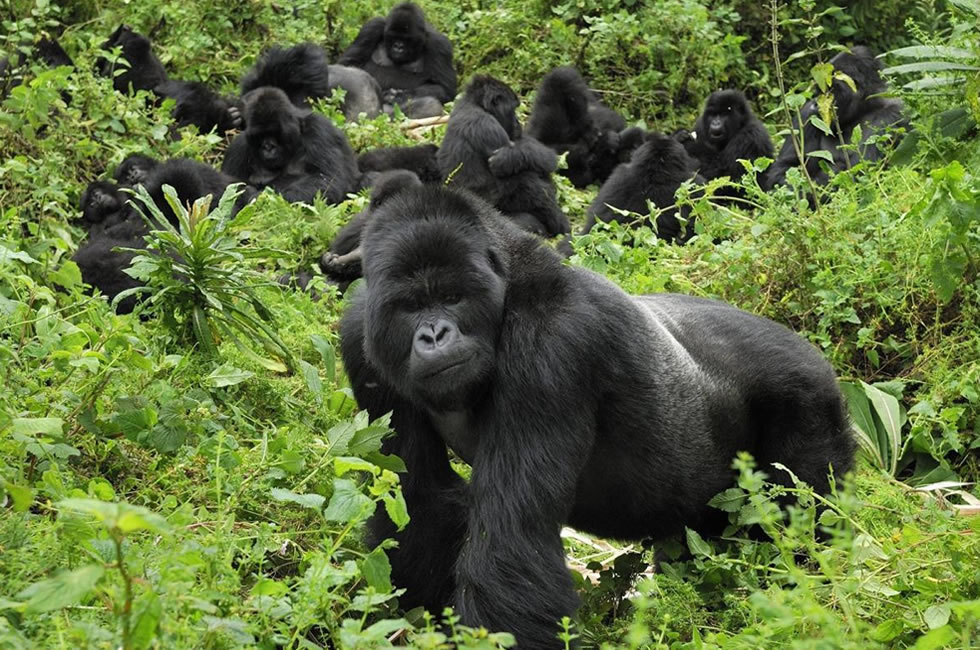
Go Gorilla Trekking: Uganda Vs Rwanda
A trek to view the critically endangered mountain gorillas in the wild is incomparably the rarest experience that comes once in a life time. Whereas gorilla trekking has become the world’s most sought after and repaying adventures to trekkers on safaris to Africa, there is ongoing debate about where to go to trek these charismatic wild creatures.
Most travelers have found it challenging to choose between gorilla trekking in Uganda and Rwanda and hence questions such as which is the best destination to go for a gorilla trek Uganda or Rwanda? Which is more viable or cheaper – Bwindi Forest National Park or Rwanda’s Volcanoes National Park, which is easier to access? Is trekking gorilla in Uganda better than Rwanda? The Great apes are inhabited in only three countries; Uganda, Rwanda and Democratic Republic of Congo (DRC), however due to the insecurities in DR Congo, gorilla trekking has not been as vibrant as that in Uganda and Rwanda.
With not more than 1060 individuals that are still thriving in the world, about 480 of the gorillas live in Uganda while the rest are shared between Rwanda and DR Congo. Visitors who have visited gorillas in Uganda and Rwanda have had varied views some of which are not realistic but all in all it is what they experienced. We would like to compare between gorilla trekking in Uganda and Rwanda and ascertain which is one better than the other. There are numerous factors that we want to use to make comparisons between the two destinations as explained below;
Accessibility to Uganda and Rwanda
Most gorilla trekking safaris in Uganda are only conducted in Bwindi Impenetrable Forest National Park and Mgahinga Gorilla National Park in the Southwestern part of the country. For trekkers to access these destinations means they have spend nearly 9-10 hours drive from Kampala city while trekkers to Volcanoes National Park in Rwanda can send about two and half hours driving from Kigali International Park which puts Rwanda at a higher comparative advantage. However, while traveling to Bwindi or Mgahinga Gorilla National Park, visitors have higher chances of getting pre-trekking experiences along the way. Visitors can make a stop at the Equator at Lake Mburo or Queen Elizabeth National Park. At Queen Elizabeth Conservation Area, visitors have opportunity to sight at the rare tree climbing Lions at Ishasha sector as well as the general scenic beauty of the area which isn’t a case with Rwanda.
Gorilla trekking permits
To trek mountain gorillas in any of the ten habituated groups, the cost of permits is $1500 per person and it applies to all categories of visitors whereas in Uganda gorilla permits are obtainable at $600 per person for foreign non residents, $500 for foreign residents and shs.250000 for East African residents and this is relatively cheaper compared to Rwanda. Besides, during the low season Uganda Wildlife Authority issues discounted permits at $450 for foreign non residents, $400 for foreign residents and shs.150000 for East African residents and this applies in the months of April, May and November. We realize that Rwanda’s main challenge leis in the cost of gorilla permits.
Gorilla trekking experience in Uganda and Rwanda
Uganda offers visitors two options to track the critically endangered mountain gorillas which means that trekkers will visit Bwindi Impenetrable National Park where over 400 gorillas live representing about half of the Great apes in the world. Therefore there are about 11 habituated gorilla groups that have been set for tourism purposes in Bwindi and as well, there is Gorilla Habituation Experience for trekkers to par take in Bwindi making it the most exceptional protected area in the world. The other option is Mgahinga Gorilla National Park which inhabits about 80 of individuals featuring one habituated family for visitors to realize their dreams. In total, Uganda has 12 gorilla groups set for tourism, meaning a large number of trekkers are not left out choice to realize their dreams. Besides, Uganda has four trailheads where trekking takes place especially in Bwindi Impenetrable Forest and they include Buhoma, Ruhija, Rushaga and Nkuringo sector. In Rwanda, Volcanoes National Park is the only place where gorilla trekking is conducted and features ten habituated groups.
However, in Bwindi Forest National Park, the gorilla families may be found in distant areas from the park headquarters and involves hiking through he thick vegetation and hilly sides which also comes with challenging adventures but for visitors who can not manage carrying their luggage, there porters to be hired to help relieve you from the heavy luggage. The thick vegetation in Bwindi some times makes it a challenging for trekkers to take pictures of these intelligent Apes in the wild. Gorillas in Volcanoes National Park live within the altitude 2500 meters and beyond offering visitors a higher opportunity to encounter these rare primates and also to take photographs.
The People Around the Parks
Regardless of the long distances to arrive at gorilla habitat, Uganda is incomparably a cultural melting pot featuring over 60 indigenous languages belonging to 5 varied linguistic groups, and an equally diverse cultural mosaic of music, art and handcraft. Visitors who are planning for their gorilla safaris to Uganda therefore have opportunity to encounter the unique Batwa pygmies as well as the Bakiga around Bwindi Forest. The Batwa culture is remarkable on its kind and it is undoubtedly Uganda’s main cultural attraction when you visit the Batwa community. After gorilla adventures in Bwindi or Mgahinga National Park, tourists can also participate in distinct activities such as the Batwa trail, traditional dances, music performances, community walks, forest walks. The sweetest moments of the Batwa trail is when you are caught up in the pitch dark cave, then sweet voices in harmony sizzle from nowhere before the torches are switched welcome you. The theater stage has cast of children and women dressed on leaves strangulate their vocal chords in praise of the gods, the beautiful girls or past on ancestor. It is in deed authentic African experience not to be missed while on gorilla trekking safari in Uganda. Whereas in Rwanda, it may be hard for you to encounter such exceptional cultural experiences like it is a case in Uganda.
In conclusion, Uganda and Rwanda East Africa’s ultimate mountain gorilla destinations offering the most thrilling experience of a life time. You can visit both Uganda and Rwanda to find out the differences in this life time experiences. However, gorilla trekking in both countries is remarkable on their own as trekkers get varied satisfaction levels of encounters as well as value for their money. You can either travel from Uganda to Rwanda or Rwanda to Uganda.
Read More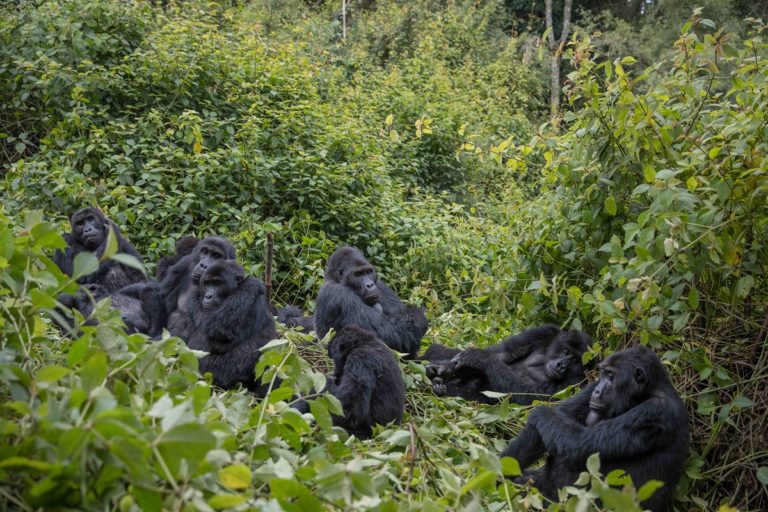
Meet the Eastern Lowland Gorillas of Kahuzi Biega
In the Democratic of Republic Congo, Kahuzi Biega National Park is a protected area near Bukavu Town in eastern part of Congo. Situated near the western bank of Lake Kivu and the Rwandan border, Bukavu is a city in eastern Democratic Republic of the Congo (DRC), lying at the extreme south-western edge of Lake Kivu, Kahuzi Biega is one of the biggest national parks in the country hosting both mountainous and lowland terrain. Kahuzi Biega National Park is the last major sanctuary of Grauer’s lowland gorillas and it is one of the last refuges of the rare species of the Eastern lowland gorilla and endangered species category under the IUCN Red List.
Kahuzi Biega is one of the best wildlife protected area in Democratic Republic of Congo (DRC), safe and well managed national park. The gorilla trekking tour experience is less tiresome compared to the Mountain gorillas in the Virunga Volcanoes. Our best experience ever was with the low land gorillas of Democratic Republic of Congo located just from Bukavu town south east of Democratic Republic of Congo bordering Rwanda in the west. The eastern lowland mountain gorillas in the park are well managed and visited them was facilitated through Budget Gorilla Trekking. If you are in south Kivu for a weekend then I recommend the experience of visiting the gorillas in their own habitat.
This is to say about the trekking of Low land gorillas in Kahuzi Biega National Park in southern Kivu province, which is a perfect experience like the same when trekking mountain gorillas in the Volcanoes and Bwindi Forest parks.
Bukavu and Kahuzi Biega are very safe for tourism. Beautiful view of Lake Kivu, short distance to the lowland gorillas, I advise all tourists in the region to come and visit the Kahuzi Biega National Park. This place is unique, just one hour and half driving from Bukavu. The rangers are very dedicated and professional as they are in the Virunga National Park in North Kivu but in Kahuzi Biega they receive fewer visits. Apparently, not many people know that this park is safe for tourists and that offers gorillas trekking, camping and hiking. It is also less expensive than in Rwanda and Uganda.
The beautiful drive from Bakavu to the park skirts Lake Kivu enters highland tea plantations and is a good way to get a feel for rural life. The hike into the mountain of south Kivu leads to the undisturbed jungle habitat of wild silver gorillas.
Once you are in the park, walking to meet the gorillas can surprisingly be quite fast and will definitively much cheaper than in Rwanda and Uganda. By picture you could realize how this animal is really nature with amazing and has its unique look and family nature with mountain gorillas. This region must continue taking of these animals and it should keep safe the security enforcement. The gorilla encounter itself is beyond description, truly a once in a lifetime experience to be so close to these gentle giants and to have a chance to see them interact with their environment and each other in ways that are both humorous and tend to witness behaviors that are so very human. It is good wear long and light clothing to protect yourself from thorny bushes and the many mosquitoes and ants, take water and be prepared to walk and get your shoes wet, so trekking waterproof shoes are recommended.
A boat cruise on lake Kivu is very beautiful, lake Kivu covers part of Congo and Rwanda which diversity of very clear outlooks of the islands, vegetation and birds of the air that are always feeding on small fish in the waters whole singing softly which enables everyone that takes on such an experience to enjoy it extensively throughout their stay around Congo.
Given that the DRC doesn’t have a lot of tourism like other neighboring countries, this might be the cheapest gorilla visit you will find. Still this means $400 per person if you are not a DRC resident. The visit includes a security briefing and a small story about gorillas that live there and then you go for a walk with a park ranger to see them. Make sure to take your yellow fever card as they will ask for it everywhere. The Congolese people are friendly and helpful and the eastern Congo is a lush and enormous landscape of beautiful mountains and lakes. A visit to Kahuzi Biega National Park is a thrilling adventure travel to an environmental paradise.
Read More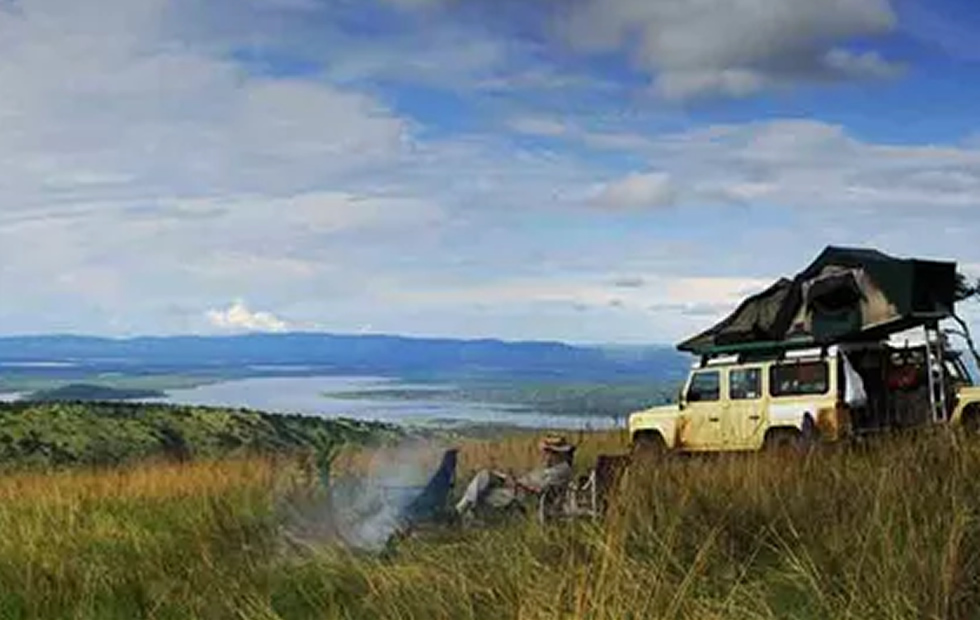
How to Choose a Rwanda Car Rental Company
Hiring a car is one thing any traveler on Rwanda safari should put into consideration. It is what makes your safari complete but the Rwanda car rental company you choose to deal with also matters a lot. Whereas others opt to borrowing from friend or family or embarking on public means, they are not the best options if you are interested in flexible road trip that is why dealing with a reliable car rental agency is best way to go.
To guide well when choosing the best agency to for Rwanda car hire, the following factors should be put into consideration;
- Do Research
As mentioned earlier in our post, there are many car rental companies that you can find all over across various countries. Before you make an effort to hire one, it is advisable to ensure that you conduct enough research. When you spare your time to find out more about car rentals, it becomes easy to find a car rental firm that will suit your needs. Also, ensure that you consider using top-rated car rental websites to get the latest information.
- The rates for car rental
When choosing a car hire company to deal with, take note of the rates of car rental. Each car hire agency in Rwanda has its set prices for car hire which you need to be aware of before you make your last choice. To be on safer side, we advise our clients to spare sometime and research on different car rental companies to get to know about their rates. This is one way that you can make comparison such that you find the best car rental agency with pocket friendly rates and the best offers. Also do not be mistaken that the high rates reflect better services at times it is not the case and again do not be moved by cheap things as they may cost on your wallet.
- Reputation
If you want to hire a car rental company, make sure that you consider its reputation. Most of the companies are widely known for their reliable and quality services that they offer to their customers. That is why it is paramount to read online testimonials and reviews before you make your final decision. Hiring a reputable company means that you are secured and safe while on the roads.
- Fuel
Different Car Hire Company may or may not quote fuel rates and even when they do, you will realize that others quote a high or low rate. Meanwhile others rent a car out with fuel and you are expected to bring it with same quantity of fuel and bridge of agreement may mean a cost on your wallet. Before you make your decision, make sure that you know fuel policy of a particular Car Rental Company you hope to deal with.
- Customer Care Services
When hiring a car rental company, it is vital to take your time and visit the company before hiring it. Once you arrive at the intended company, take your time to identify the quality of services that they deliver to their customers. A professional company will ensure that they meet the needs of their clients, and as a result, they will provide quality customer service. That is why you should hire a car rental company that provides quality and satisfying customer services to their customers.
- Road assistance
When choosing for Car Hire Company or agency to deal with, make sure that you inquire more on breakdown-if there is any provision for rescue of car and if you will be required to pay addition amount or not. However, most car hire agencies off a 24hour road assistance although you do not need to assume that it happens to all.
- Additional costs
Did you know that there are hidden costs/charges that some car rental companies do not tell clients online but when booking they disclose to you? Do not be taken by surprise with a new charge presented to you at the end of day/actual day of hiring a car. Ask and find out what your quotation includes or excludes.
- Insurance
Different car hire companies have their own set insurance policy or terms and conditions. Because of this, you need not to assume that this applies to all or they all provide comprehensive or third-party insurance. To be on safer side, you have to inquire more about this. Usually, insurance policy covers the car rental only while others include the visitor’s life and property. On the other hand, other agencies may require you to purchase your own or for the car too.
- Mileage provided
Each Car Hire Company has its mileage provision. Some offer unlimited while others limited. You are required to inquire more about what mileage the company you hope to deal with offers to avoid incurring unexpected charges.
- Car Selection
Cars are hired for different reasons. Since you need a car rental company, make sure that you take your time to check on the available types of vehicles that a given company offers. For example, if you are planning to travel with your family, you should look for a car rental company that provides various cars that will accommodate your family. In other words, you should hire a company that has a wide range of vehicles that will suit your needs.
- Location of the Car Rental Company
Many companies have been established to offer car rental services. One should consider the location of the car rental company to minimize cost and reduce time it takes to access the car services. This company is located in the major cities and arrangements can be made for the car to be delivered to one’s location.
- Car Rental Terms
It’s vital you consider the car rental terms before making the final decision. Make sure that you read all the details and seek clarification on any information that you do not seem to understand. Not complying with the car rental terms can cost you more money, if all the requirements are not met.
- Drop-off times & location
The drop off time and the company’s rules towards it are among the most vital factors to consider before hiring a car. It is good to look for service providers that are inexpensive and lenient as far as drop off locations is concerned.
- Value Addition
Ask the convenience that the company offers before making a final decision. There are service providers that offer online bookings. Without a doubt, online interaction will save time and stress. Some car rental companies may offer a bundle deal with discounted price for several extra items like GPS units, child seats, booster seat, roof racks for an additional fee. Most car rental companies do not allow smoking in the car. Car rental companies will charge you a cleaning fee in case you do so. Some rental car companies may or may not charge for a chauffeur.
Read More
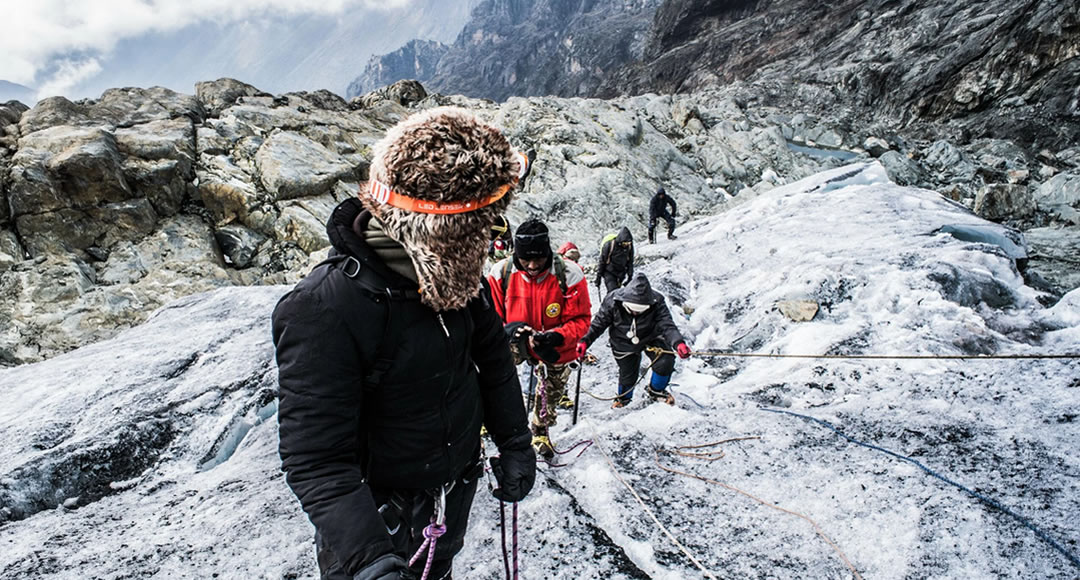
10 Things to Know About Rwenzori Mountains
Nestled in the heart of Africa, the Rwenzori Mountains stand as a towering testament to nature’s unparalleled beauty and allure as they are legendary known as the “Mountains of the Moon.” The magical mountain ranges are located on the border between Uganda and the Democratic Republic of Congo (DRC) in East Africa. The mountains host the 3rd highest summit – Margherita on Mount Stanley on the African continent after Kilimanjaro of Tanzania and Mount Kenya. Trekking the mystic Rwenzori mountains is one of the unique experiences that one should not miss. The wonder of the high glaciers and beauty of the valley of nine lakes, are some of the things that will motivate you to trek the Rwenzori Mountains.
Protected by a UNESCO World Heritage Site –the Rwenzori mountains national park, there are several key points one should be knowing and take note about the glaciated mountains of the moon and among these include;
Geography and Location
The Rwenzori Mountains stretch for about 120 kilometres (75 miles) along the border between Uganda and the DRC. They are part of the Albertine Rift, which is the western branch of the East African Rift System. They are protected by Rwenzori mountains national park which covers an area of approximately 1,000 square kilometers in the south-western part of Uganda in the districts of Bundibugyo, Kabarole, and Kasese.
Highest Peak
The highest peak in the Rwenzori Mountains is Margherita Peak on Mount Stanley, one of the massifs of the Rwenzori ranges. The peak stretches at a height of 5,109 meters above sea level and it known as the highest in Uganda and Democratic Republic of Congo and then the third highest mountain in Africa after Mount Kilimanjaro and Mount Kenya.
Mountaineering
Hosting the third highest peak of Africa – Margherita, Rwenzori Mountains offer excellent opportunities for mountaineering and trekking experiences. The most popular trekking route is the “Central Circuit,” which takes trekkers through various ecosystems and landscapes, from lush rain forests to alpine moorland and snow-covered peaks.
Glacial Environment
The Rwenzori Mountains are unique for their glacial environment near the equator. They are home to several glaciers and snowfields, although these have been receding due to climate change. The glaciers are an important water source for local communities and ecosystems.
Biodiversity
The Rwenzori Mountains are recognized for their high biodiversity, including many species of plants, animals, and birds that are endemic to the region. The mountains feature 54 Albertine rift endemics that include 18 mammal species, 21 birds, 9 reptiles and 6 amphibian species. The area was designated a UNESCO World Heritage Site in 1994 for its exceptional natural value.
Cultural Significance
Rwenzori Mountains are known for their beautiful and unique cultural significance for local communities, particularly the Bakonjo people who inhabit the slopes of the mountains. The mountains have been woven into their myths, legends, and daily lives for generations. As you travel to the mountains, have some good time with the locals as they entertain you through dances, songs and drama playing.
Challenges
Trekking to the summit of the Rwenzori Mountains can be physically demanding due to the steep terrain, unpredictable weather, and high elevation. Adequate preparation, including acclimatization, is essential for a safe and enjoyable trekking experience.
Conservation Efforts
Conservation organizations and governments have been working to protect the unique biodiversity of the Rwenzori Mountains and address the impacts of climate change on the glacial environment. Efforts are also made to ensure that tourism and trekking activities are sustainable and do not harm the fragile ecosystems.
Access
The main entry point for exploring the Rwenzori Mountains from the Ugandan side is the town of Kasese. Trekkers usually start their journey from the base camp at Nyakalengijja when hiking through the route of the central circuit – the most common and easiest trail.
Weather
The weather in the Rwenzori Mountains National Park can be unpredictable and can change rapidly. Rainfall is common throughout the year, and trekkers should be prepared for wet and muddy conditions.
Overall, the Rwenzori Mountains are a remarkable natural and cultural treasure, offering a unique blend of biodiversity, glacial landscapes, and cultural heritage for those who venture into their heights.
Read More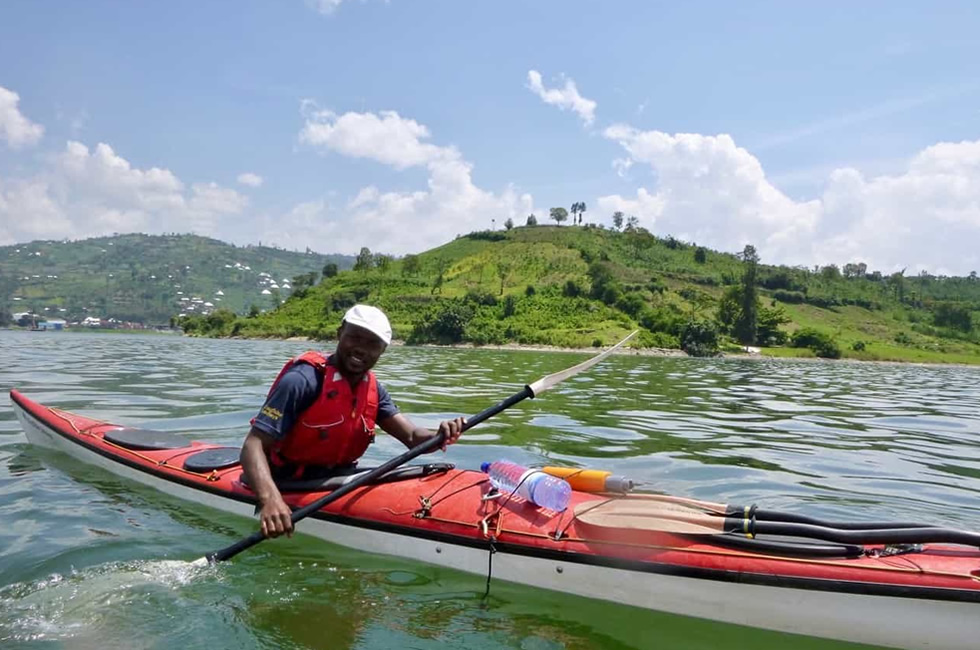
Canoeing Experience in Rwanda
Are you planning your safari to the African continent but still wondering on where to have the best stress-free experience? With a number of water bodies in different areas, the Republic of Rwanda has got you covered with the best canoeing experience. The country has a total surface area of 26,338 square kilometers with over 10 water bodies like lake Kivu, River Akagera, Lake Ihema, and many others that are safe and best for canoeing. Among the places/water bodies where the experience takes place include the following;
Lake Kivu
Lying on the border between the Democratic Republic of Congo and Rwanda, Lake Kivu is one of Africa’s Great Lakes and a stunning location for canoeing. The lake offers a serene and peaceful setting with beautiful views of the surrounding hills and volcanoes. Canoeing on Lake Kivu allows you to explore its shores, visit small islands, and witness local fishing activities. It’s an excellent opportunity for birdwatching and taking in the natural beauty of Rwanda’s western region.
Canoeing in Akagera National Park
Located in the eastern part of Rwanda, Akagera is Rwanda’s largest national park stretching at an area of approximately 1,122 square kilometers and is known for its diverse wildlife. The park has several lakes and waterways where canoeing is done and among these include Lake Ihema, Lake Shakani, Lake Gishanju, Lake Mihindi and Lake Rwanyakazinga. Canoe safaris in Akagera provide a unique perspective to observe hippos, crocodiles, and various waterbirds up close, as they are often found near the water’s edge. It’s a peaceful and intimate way to experience the park’s abundant aquatic life and landscapes.
Whether you are a beginner or an experienced canoeist, there are options for guided canoe trips tailored to your skill level and interests. There are different rangers who will help you prepare and get used to the calm waters as you enjoy the activity.
Apart from canoeing experience, there are several other activities done on Rwanda safari and among these include; gorilla trekking and golden monkey tracking in Volcanoes national park, Chimpanzee trekking in Nyungwe forest national park, nature walks and hiking, city tours in the beautiful and clean Kigali, wildlife watching in Akagera national park, bird watching, and many others. For the best and safe encounters, book with an authorized and registered tour operator like Primate Safari Experiences limited which designs the best and affordable tour packages in countries like Rwanda, Uganda, Congo, Kenya and Tanzania.
Read More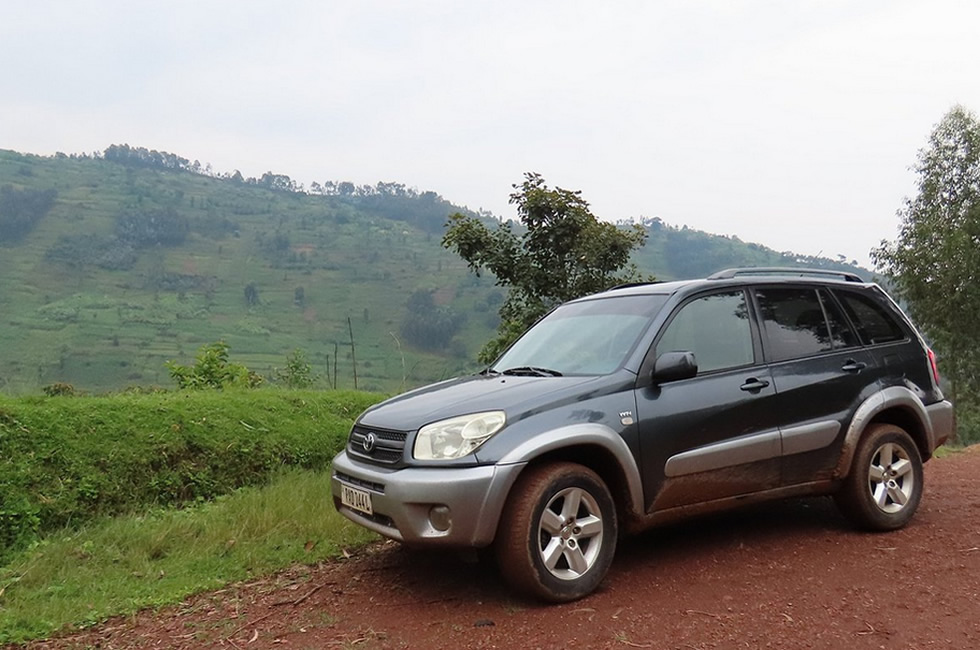
Why You Should Hire a Car in Rwanda?
Rwanda, known as the “Land of a Thousand Hills,” is a breathtakingly beautiful country in East Africa that offers a unique and memorable travel experience. From its stunning landscapes and vibrant culture to its diverse wildlife and rich history, Rwanda has become a popular destination for adventurers and nature enthusiasts alike. One of the best ways to explore this remarkable country is by booking a rental car. Here are several reasons why renting a car in Rwanda is a great deal.
Freedom and Flexibility
When you rent a car in Rwanda, you gain the freedom and flexibility to explore the country at your own pace. You are not bound by the restrictions of public transportation schedules or dependent on tour groups. With a rental car, you can create your own itinerary, choose your destinations, and take detours whenever you please. Whether you want to spend a day exploring the vibrant capital city of Kigali, go on a thrilling wildlife safari in Akagera National Park, or visit the awe-inspiring Volcanoes National Park, having a rental car gives you the freedom to make the most of your time and experience Rwanda on your terms.
Scenic Drives
Rwanda is renowned for its breathtaking scenery, and driving through the country allows you to immerse yourself in its natural beauty. From rolling hills and lush tea plantations to picturesque lakes and dense rain forests, the landscapes of Rwanda are truly mesmerizing. Booking a rental car enables you to embark on scenic drives, such as the renowned Lake Kivu loop, where you can witness stunning views of the lake and its surrounding hills. The drive from Kigali to Volcanoes National Park is also a must-do, offering captivating vistas of the countryside and the opportunity to see the majestic mountain gorillas.
Accessibility to Remote Areas
While Rwanda has a well-maintained road network, some remote areas may be challenging to access without a private vehicle. Renting a car provides you with the ability to reach off-the-beaten-path destinations and explore lesser-known gems. For instance, you can venture to Nyungwe Forest National Park, home to a remarkable diversity of primates and one of the oldest rain forests in Africa. Having a rental car enables you to navigate the country’s roads and reach these remote areas, granting you the chance to discover hidden treasures and create unforgettable memories.
Cost-Effective Travel
Contrary to popular belief, booking a rental car in Rwanda can be an affordable option for travelers. The country offers a range of car rental companies with various vehicle options, allowing you to find one that suits your budget. Additionally, by having a car at your disposal, you can save money on transportation costs in the long run. With public transportation, you might need to hire taxis or join organized tours, which can add up over time. By renting a car, you can optimize your travel budget and allocate your funds towards other experiences or accommodations.
Enhanced Safety and Convenience
Rwanda is a safe and welcoming destination for tourists, and renting a car adds an extra layer of safety and convenience to your journey. With your own vehicle, you have control over your transportation, ensuring a secure and comfortable travel experience. You can store your belongings safely, avoid crowded public transport, and have the convenience of traveling directly from one attraction to another without the hassle of coordinating with multiple transportation modes.
In conclusion, booking a rental car in Rwanda is undeniably a great deal for travelers. The freedom, flexibility, and accessibility it offers allow you to maximize your time, immerse yourself in the country’s stunning landscapes, and explore hidden treasures. Moreover, renting a car can be cost-effective, providing you with the opportunity to allocate your travel budget.
Read More
Going on Safari in Rwanda
Rwanda is renowned for its amazing gorilla trekking holidays in Volcanoes National Park. Trekking through the dense rain forest of Rwanda in search of mountain gorilla families is one of the most profound experiences that you can enjoy in the natural world.
Situated in the far northwest of Rwanda, Volcanoes National Park protects the steep slopes of this magnificent mountain range – home of the endangered mountain gorilla and a rich mosaic of montane ecosystems, which embrace evergreen and bamboo forest, open grassland, swamp and heath.
Tracking endangered mountain gorillas through the mysterious intimacy of the rain forest, alive with the calls of 200 species of colorful birds and chattering of the rare golden monkey, is only one of the truly unique experiences in the area.
The cost of a single gorilla permit in Rwanda is US$1,500 for visitors from outside Africa. Also, there is a discounted gorilla permit from November to May and it always applies when you are visiting one or two more Rwanda parks. Again, for the citizens of Rwanda and other East African countries have an offer of $200. The best time to visit Rwanda is during the dry season of June to October. This is also the best time of year to see mountain gorillas in Rwanda as these periods offer the best hiking conditions and the lowest risk of malaria.
Volcanoes National Park is the site of primatologist Dian Fossey’s Karisoke Research Station, where she led a team to study gorillas in the wild. You can undertake about a 2-hour hike to her tomb, which is – like so much in Rwanda – both moving and inspiring, or discover more about the Dian Fossey Gorilla Fund.
The hike is considered one of the best, most intimate tours in Rwanda, and offers a great opportunity to look out for primates, hogs, forest elephants and a plethora of bird species. There are a few troops of habituated golden monkeys, whose antics are great fun to watch. Golden monkeys are endangered, and permits are required for trekking.
Volcanoes National Park also shelters five of the eight volcanoes of the Virunga Mountains which are: Mount Karisimbi, Mount Bisoke, Mount Muhabura, Mount Gahinga and Mount Sabyinyo) covering over 160 km2 of rain forest and bamboo.
During gorilla trekking you will embark on your hikes to the different Virunga Mountains depending on the different gorilla groups that are assigned to you, for instance, the Karisimbi gorilla group is found on mount Karisimbi, the Ugenda gorilla family is usually found along the slopes of mount Sabyinyo among other gorilla families.
The gorilla trekking process in the park is quite interesting because you will get to see a number of attractions including the different bird species, the golden monkeys among other species. In the park, you will get to the bamboo trees where the gorillas are found, you will get to see the behaviour of the gentle giants while in the wild, for instance, their feeding patterns you will see infants suckling the breasts of their mothers for food, you will also see them eating the bamboo trees which is quite an exhilarating experience to come in contact with the primates which you will see in an hour you get to spend with the gorillas, photography can also be carried out to keep exciting memories of your experience with the gentle giants.
Read More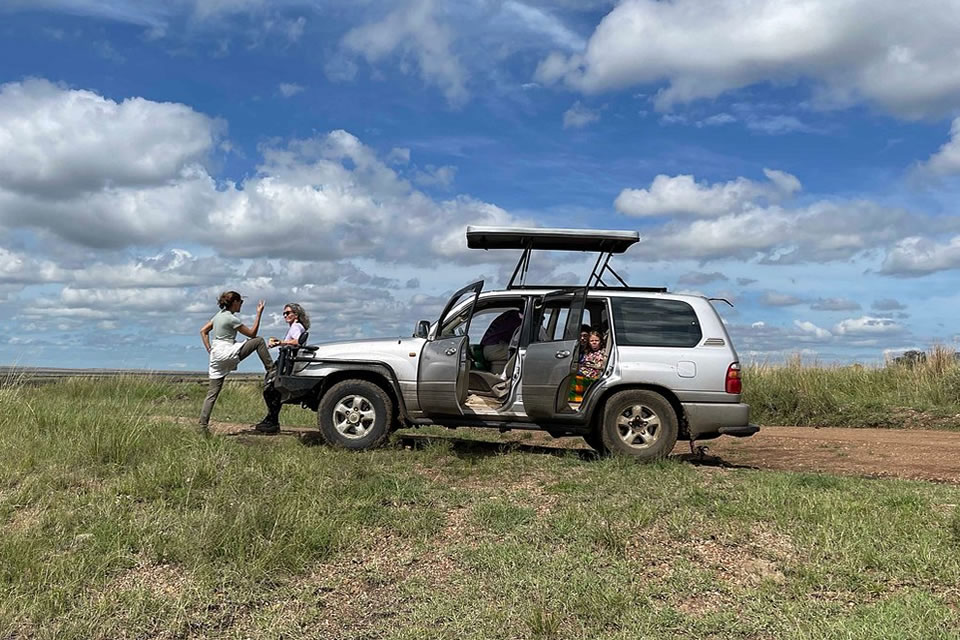
Uganda Self Drive Safari: Why Book Your Car Early?
Are you interested in self drive safari in Uganda? Self dive trips are by far the most sought after experience by travelers. Booking for a car of your choice is the most important thing that any traveler must do if you are to get the perfect safari experiences in Uganda. We appreciate the availability of internet, booking flights or contacting a tour company is no longer a debatable issue, it only takes you less time to reach to us for any help related to car hire/rental and self drive safaris in Uganda. Why is it important for you to book for your car in advance in Uganda?
Below are reasons;
You will have adequate time to plan for the journey
Booking a tour in advance offers traveler a lot of time to finish all their planning process. Adequate planning of your safari is very vital. It gives tourists ample time to do their shopping for clothes and travel accessories that may be of value for the safari. Make sure that you have your checklist by your side so that you do not leave out anything valuable. You can as well visit in any of Uganda’s local library or book store and spend some money in guidebooks. You can sit down with your family members and start selecting the activities that can excite you while in a safari in Uganda. Booking a car in advance also offers travelers adequate time to organize essentials like getting passports renewed and other vital vaccinations for the safari.
Wide range of choice
There are very many car rental companies in Uganda and by booking for your car in advance the best way for you to weigh different offers from various companies so that you up with the best choice. Equally, the perfect low budget lodges in Uganda usually get booked up during the peak season. Booking in advance means visitors have a lot of time to choose best pocket friendly safari accommodation to spend a night. The most magnificent places in Uganda include Murchison Falls National Park, Queen Elizabeth National Park and Bwindi Forest National Park. These destinations are highly booked during the peak season. You can book for your safari holiday in advance at least few months before traveling.
There are various drivers who are ready at the airport to offer you transport services but the unfortunate bit of it is that, the prices are just crazy with other hidden and inflated costs on your safari for instance parking fees, over time among others. These additional costs in most cases are not too much but will make you inconvenienced and definitely sad especially when your safari becomes expensive more than what you expected. You can only run away from this kind scenarios by simply booking a self drive car in advance or even book it with one driver and have the most fascinating travel experience with us.
It also breaks the assumption that drivers usually have that when you get out of the airport the next thing is to connect to the major city immediately. Since there is no public transport in the airport, at the same time you don’t have any one whom you are waiting for with car, the only alternative is for you to book for your self drive car in advance and it will right there as soon as you step at the airport.
In case you are planning to travel to Uganda it is advisable that you book your car at least 6 months in advance such that when you arrive at the airport, you are in position to find a driver waiting for you. Booking a car rental in Uganda is simpler now with online services and once you arrive at the airport, you get someone holding a paper with your name highlighted, after you will be taken where your booked car is to sign the agreement and you will set off with your car. By so doing you would have saved both money and time.
In conclusion we encourage you to book for your car in advance so that we confirm your booking before you arrive to Entebbe International Airport. This will also assist you on how you can connect from the airport to Kampala and other destinations that might be of interest to you.
Read More